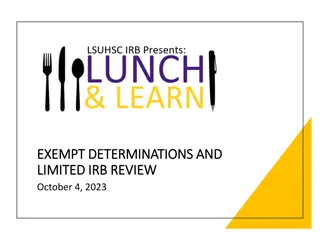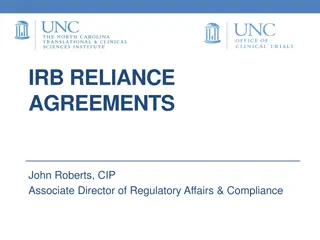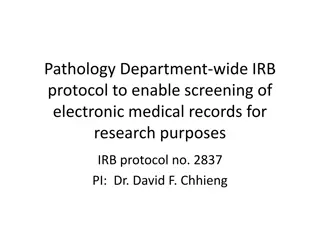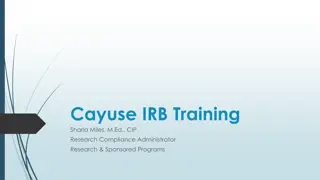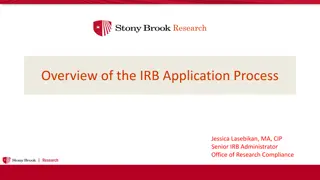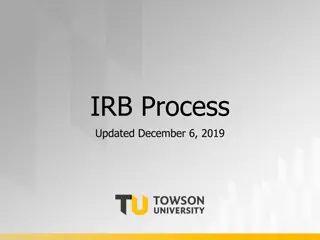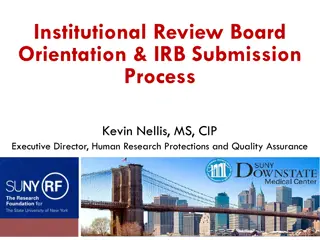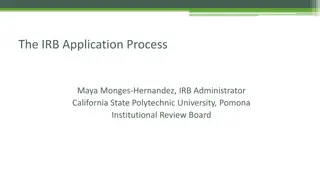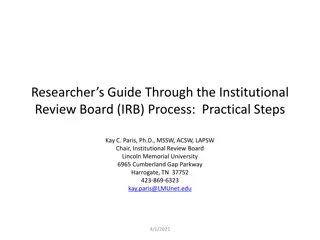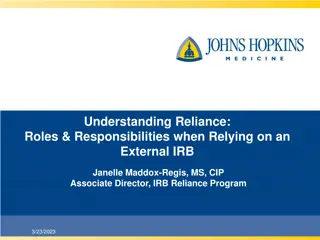Villanova IRB New Investigator Training Overview
Human Subject Research Protections at Villanova IRB, including regulatory background, review process, and key information for investigators. Learn about the Institutional Review Board structure, ethical principles, and historical background of human subjects research at Villanova University.
Download Presentation

Please find below an Image/Link to download the presentation.
The content on the website is provided AS IS for your information and personal use only. It may not be sold, licensed, or shared on other websites without obtaining consent from the author. Download presentation by click this link. If you encounter any issues during the download, it is possible that the publisher has removed the file from their server.
E N D
Presentation Transcript
IRB NEW INVESTIGATOR TRAINING Version: March 2021
OVERVIEW Human Subject Research Protections at Villanova IRB structure at Villanova Regulatory Background IRB review process at Villanova Post approval and closure of studies 2
HUMAN SUBJECT RESEARCH PROTECTIONS AT VILLANOVA Human subjects research at Villanova: Follows federal regulations regardless of funding source. Holds all human subjects research to the same standards. Human Subject Protection Policies are: Approved by the Institutional Official (IO) at the recommendation of the IRB. Outlined in the Villanova HRPP Plan [HRPP Plan]. 3
IRB AT VILLANOVA The Villanova IRB: Is chaired by an experienced researcher. Has a focus and expertise on Social-Behavioral Research. Has members from various departments with diverse expertise. Has community members required per federal regulations. Provides approvals in writing. The IRB process at Villanova aligns with regulatory requirements, the HRPP Plan and is consistent with peers. The Office of Research Protections (ORP) provides administrative support to the IRB. On behalf of the IRB, ORP receives all protocols and sends out all approvals. 4
KEY INFORMATION FOR INVESTIGATORS All projects involving human subjects should be presented to the IRB to determine if the protocol meets the definition of research per federal regulations and requires review. The IRB is the only regulatory committee authorized to approve your research study at Villanova. Villanova University does not distinguish studies based on the source of funding. Departmental approvals are required for conducting research. The investigator handbook is the reference source for PIs. [Investigator Manual] 5
REGULATORY BACKGROUND The upcoming sections address: Historical Background Definition of Human Subject Definition of Research Qualifications of an Investigator 6
HISTORICAL BACKGROUND
Basic Ethical Principles: Respect for Persons Beneficence Justice HISTORICAL BACKGROUND: 8
RESPECT FOR PERSONS Treat individuals as autonomous agents. Do not use people as means to an end. Allow people to choose for themselves. Give extra protection to those with limited autonomy. 9
BENEFICENCE Acts of kindness or charity that go beyond duty. Obligations derived from beneficence: Do no harm Prevent harm Prevent evil Promote good 10
JUSTICE Treat people fairly. Fairly share burdens and benefits of research. Distinguish procedural justice from distributive justice. 11
HUMAN SUBJECTS RESEARCH
DEFINITION OF HUMAN SUBJECT Human Subject, as it pertains to research in the HHS regulations, is defined in 46.102, Subpart A. A living individual about whom an investigator conducting research obtains information or biospecimens through [intervention] or [interaction] with the individual, or [individually identifiable] [private information]. 13
DEFINITION OF INTERVENTION Intervention, as it pertains to research involving human subjects is defined in 46.102. It includes both: physical procedures by which data are gathered (for example, venipuncture) and manipulations of the subject or the subject s environment that are performed for research purposes. 14
DEFINITION OF INTERACTION Interaction, as it pertains to research involving human subjects is defined in 46.102 and includes: Any communication or interpersonal contact between an investigator and subject. 15
DEFINITION OF IDENTIFIABLE INFORMATION Individually Identifiable information, as it pertains to research involving human subjects is defined in 46.102. The identity of a subject is or may be readily ascertained by the investigator or readily associated with the information. In addition, OHRP generally considers private information or specimens to be individually identifiable when they can be linked to specific individuals by the investigator(s) either directly or indirectly through coding systems. This is according to NIH s Guidance on Research Involving Coded Private Information or Biological Specimens 16
DEFINITION OF PRIVATE INFORMATION Private Information, as it pertains to research involving human subjects is defined in 46.102 and includes: information about behavior that occurs in a context in which an individual can reasonably expect that no observation or recording is taking place, and information which has been provided for specific purposes by an individual and which the individual can reasonably expect will not be made public (for example, a medical record). 17
RESEARCH Research, as it pertains to protections for human subjects in research is defined in 46.102, Subpart A: a systematic investigation designed to develop or contribute to generalizable knowledge. 18
HUMAN RESEARCH Human Subjects Research should be: Conducted in accordance with the Declaration of Helsinki ethical principles. Should be consistent with applicable regulatory requirement(s). Should be in compliance with Villanova policies and SOPs. To determine if an activity is research, ask: Is the activity an investigation? Investigation: A searching inquiry for facts; detailed or careful examination. Is the investigation systematic? Systematic: Having or involving a system, method, or plan. 19
HUMAN RESEARCH CONT D Is the systematic investigation designed to develop or contribute to knowledge? Designed: observable behaviors used to develop or contribute to knowledge. Develop: to form the basis for a future contribution. Contribute: to result in. Knowledge: truths, facts, information Is the resulting knowledge generalizable? Generalizable: Universally or widely applicable. 20
HUMAN RESEARCH: IS IRB OVERSIGHT REQUIRED? Do you need to submit your study for IRB review before beginning the project? What you will do with the data matters: IRB review likely required: If you plan to publish, present, or archive your research or otherwise share the results of the study Includes uploading your results to an online or cloud- based platform. IRB review likely not required for: Human subject research that is not disseminated For example: research conducted as part of coursework that is not shared outside of the classroom; university or departmental assessments that are not shared beyond the university, etc. 21
PRINCIPAL INVESTIGATOR (PI) QUALIFICATIONS
PRINCIPAL INVESTIGATOR (PI) QUALIFICATIONS Confirmation of faculty status. All categories of faculty (teaching, tenure-track, etc.) OR Graduate Students (individuals who are obtaining either a PhD or a DNP in a subject). Assertion of standard professional credentials. Organizational approval from the Dean, Chair of the Department, or designee on protocol submissions. Completion of CITI Trainings and other required institutional trainings. 23
NEW INVESTIGATOR TRAINING Villanova University mandates completion of the Collaborative Institutional Training Initiative (CITI) training program for social behavioral modules. This is a web-based training program accessible from multiple platforms. Frequency of Training: Investigators are required to complete all modules prior to submitting a research protocol. Trainings (except COI course) expire after three years. 25
In order to conduct human subjects research, an investigator must complete the following trainings: Social and Behavioral-Basic Social and Behavioral Responsible Conduct of Research Conflicts of Interest CITI/ SOCIAL BEHAVIORAL MODULES: 26
INSTITUTIONAL REVIEW BOARD (IRB) REVIEW AT VILLANOVA UNIVERSITY
IRB AT VILLANOVA Lifespan of a protocol: PI drafts a protocol and submits to IRB for review. ORP receives protocol and conducts pre-review process ensures trainings are up to date and protocol is complete. ORP sends protocol to reviewers under review. Once returned by reviewers, ORP conducts post-review process and sends decision and any relevant information back to PI. Decision may be return to PI if there are necessary changes, exempt , or approved . 28
Cayuse IRB is an electronic system for preparing, submitting, and routing studies for IRB approval. [Cayuse] CAYUSE IRB: 29
GETTING STARTED: CREATING A NEW STUDY 1. 1. The blue + New Study button in the upper right corner will allow you to create a new submission. Your Name 2. 2. Clicking that button will bring you to the study details page. Type your study name and click the blue check box. You cannot easily change this title later on, so be sure about what you select. 30
GETTING STARTED: CREATING A NEW STUDY Your study status will be highlighted here. Your Name Study Title 1. 1. To access the full application, click on the + New Submission button, and then select Initial . Your study will be assigned a protocol number. This number will be used for the entire life of your protocol. 2. 2. Click on Assign PI , which will lead you to the full application. 31
GETTING STARTED: CREATING A NEW STUDY The interactive form will offer different questions depending on which answers you select. Study Title - Initial Optional: Use the menu on the left to navigate through your submission. All personnel (including students) listed on your application must have completed all required CITI trainings and FCOI disclosure form. See irb.Villanova.edu for list. Move your way through the form. You may save and return later if needed. You will need to include information about your study background and rationale, design, measures, etc. Note: Cayuse does not auto-save! 32
IMPORTANT NOTES The initial submission appears below Study Details. The person who creates the study is added as the Primary Contact by default. The PI needs to be assigned separately. You can change the Primary Contact when editing the submission, if needed. Click the Edit button to begin working on the initial submission. 33
MORE DETAILS The Investigator Manual provides more information about submitting Modification Continuing Review Closure There is also a complete Cayuse User Guide with step-by-step guidelines and screenshots 34
LEVELS OF RISK AND REVIEW CATEGORIES ***delete number at left
IRB OPERATIONS: MORE THAN MINIMAL RISK TO HUMAN SUBJECTS/ FULL BOARD REVIEW Full Board Review Research that is judged to involve more than minimal risk, or involves protected populations such as children, prisoners, disabled individuals or pregnant women (until Jan 2019), must undergo a fullboard review 45CFR46.103(b). These protocols are reviewed at convened meeting of the IRB, once per month. 36
IRB OPERATIONS: MINIMAL RISK TO HUMAN SUBJECTS/ EXPEDITED REVIEW Expedited Review Research that meets one of nine categories for inclusion as defined by the regulation and is found by reviewers to be no more than minimal risk. OR can be used when reviewing an active protocol for which the IRB conducted an initial review or a continuing review at a convened meeting or under an expedited review procedure during the preceding 12 months. (45CFR46.502) 37
IRB OPERATIONS: LOW RISK TO HUMAN SUBJECTS/ EXEMPT REVIEW Exempt Review A research activity may be declared exempt if it is considered low- risk and only involvement of human subjects will be in the categories outlined in 45CFR46.101 (b). Risk is minimized through non-invasive procedures or anonymity in responses. Eight categories for inclusion. 38
IRB OPERATIONS: TYPES OF IRB REVIEW 1. Initial Review The first review of a human subjects research protocol. 2. Modifications An IRB shall review and have the authority to require modifications to secure approval. (45CFR46.109(a)) 3. Annual or Continuing Review An IRB shall conduct continuing review of research covered by this policy at intervals appropriate to the degree of risk, but not less than once per year, and shall have authority to observe or have a third party observe the consent process and the research. (45CFR46.109(e)) 4. Incident An occurrence of any protocol violation, noncompliance, deviation, or serious noncompliance that is not consistent with the approved study procedures. 39
IRB OPERATIONS: TYPES OF IRB REVIEW (CONT D) 5. Withdrawal Any study that is no longer intended to be completed may be withdrawn from the system. Available for studies that have not been approved. 6. Closure Any study where all study procedures have been performed and data collection/analysis is complete. 7. Administrator Closure Similar to closure but initiated and performed by IRB Administration staff. 8. Administrator Withdrawal Similar to a withdrawal but initiated and performed by IRB Administration staff. 40
IRB OPERATIONS: SECONDARY DATA The use of secondary data is subject to IRB review if there are personal identifiers included in the data set. 41
IRB OPERATIONS: NON-REGULATED HUMAN SUBJECT RESEARCH STUDIES These types of activities are NOT subject to IRB oversight per regulations: Journalism projects Classroom projects Program evaluations Projects in which the focus is a business event Departmental or University-wide studies Biographies and case studies Case studies: descriptions of clinical features or outcomes of three or fewer patients that do not contribute to generalizable knowledge 42
IRB OPERATIONS: POST APPROVAL AND CLOSURE After your study has been approved by the IRB, you will be responsible for submitting an annual review through Cayuse each year to update the IRB on your progress. The structure of this review will vary depending on the level of review for your study. Once research covered under your protocol has finished, close your study by completing a closure form through Cayuse. 43
RISKS AND BENEFITS
RISK VS. BENEFITS: A PERFECT BALANCE Minimize Risks Maximize Benefits 45
RISKS & BENEFITS Risk to the participants The probability of harm (physical, psychological, social, legal, or economic) occurring as a result of participation in a research study. Both the probability and the magnitude of possible harm may vary from minimal to significant. The Federal regulations only define minimal risk. {AAHRPP.II.3.A} Benefits for Humanity A valued or desired outcome. Although these terms may appear straightforward, evaluations of risk and benefit are made more complex both by the subtle distinctions between therapeutic and research activities, and by evaluations of actual risks in the lives of normal and vulnerable classes of subjects (i.e., prisoners, children, cognitively impaired individuals, etc.) 46
INFORMED CONSENT
INFORMED CONSENT Informed Consent is a requirement based on the ethical principles listed below: Respect for Persons Beneficence Justice 48
INFORMED CONSENT: WHAT IS IT? All research investigators who will involve human being as subjects, covered under 45CFR46.116, must obtain legally and prospectively effective informed consent from the subject or the subject s legally authorized representative. 49
INFORMED CONSENT: CONT D Prospectively refers to the continuous process throughout the conduct of research protocol. Three key features of informed consent: Disclose information to prospective subjects to make an informed decision. Understanding what has been disclosed. Promoting the voluntariness to whether or not to participate. 50















